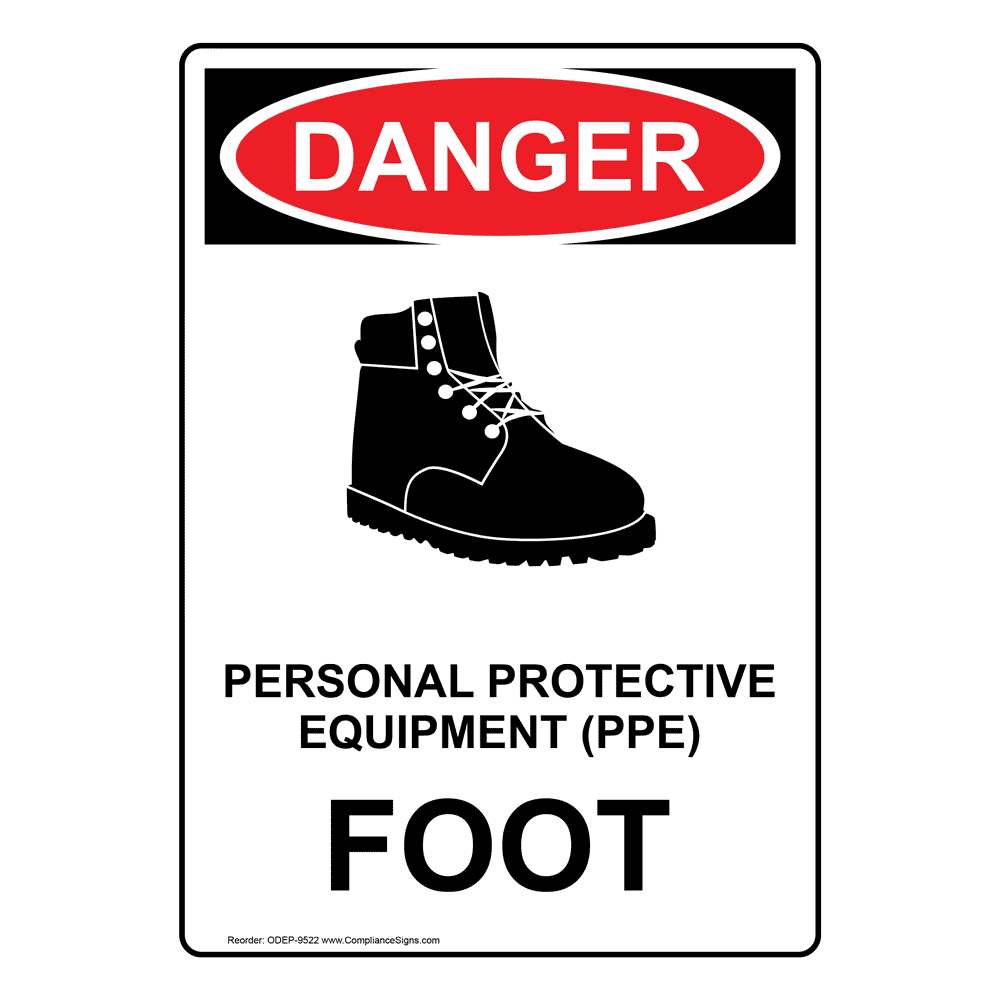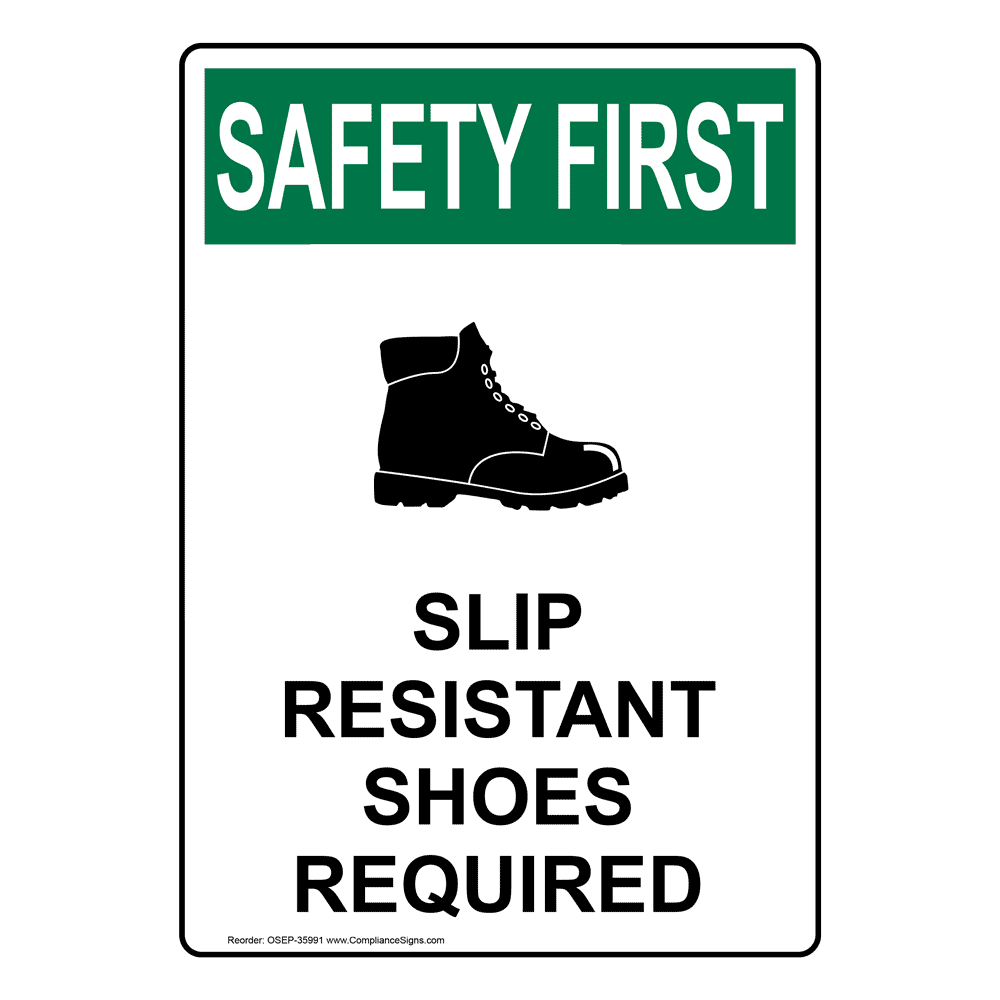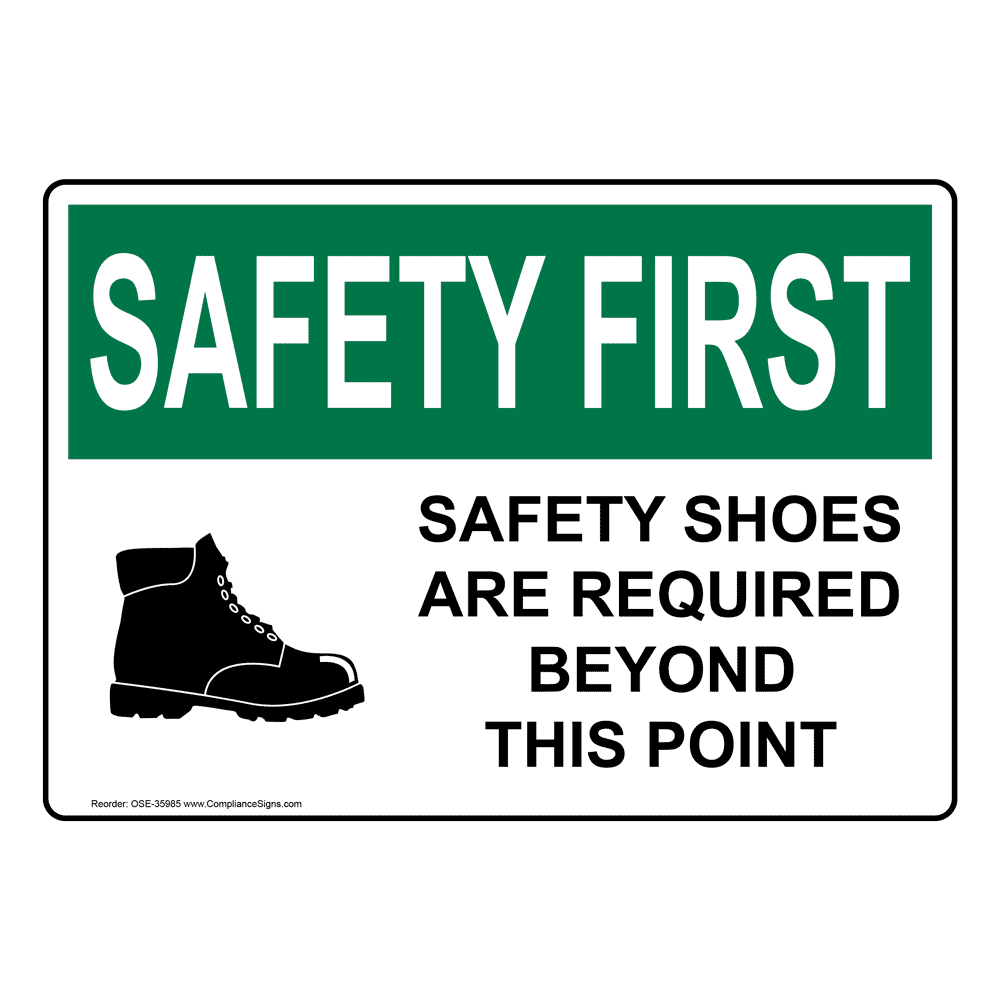Osha Standards Example : Construction
This section talks about some of the most prominent employer responsibilities regarding the safety and health of employees in the construction industry as mandated by OSHAs standards:
|
Construction Checklists can help contractors optimize the promotion and improvement of workplace safety for everyone involved in the construction site. Browse these OSHA standard checklists for the construction industry. |
What Should I Know About Safety Footwear
If you are at risk for foot injury at your workplace, you should wear the appropriate protective footwear.
- If foot protection is required, set up a complete foot safety protection program including selection, fit testing, training, maintenance and inspection.
- Safety footwear is designed to protect feet against a wide variety of injuries. Impact, compression, and puncture are the most common types of foot injury.
- Choose footwear according to the hazard. Refer to CSA Standard Z195-14 “Protective footwear” or other standards that are required in your jurisdiction.
- Select CSA-certified footwear . Ensure that it has the proper rating for the hazard and the proper sole for the working conditions.
- Use metatarsal protection where there is a potential for injury.
The OSH Answers section on Foot Comfort and Safety at Work has more information on foot care and selection of protective footwear.
When Should Safety Shoes Be Replaced
Conductive safety shoes must also be replaced if the soles are pierced, cut, or theyre way thinner than they used to be. There is no fixed time after which a pair of conductive safety shoes stop working properly: it depends on the weight of the wearer and on the type of activities he carries out at work.
Recommended Reading: Feature Shoe Raffle
Bring Together Features And Fit In Your Safety Shoe Program
Safety shoes protect workers from foot hazards, slip and falls, and even ergonomic hazards. You do need to provide workers with safety shoes when OSHA indicatres its required, but its a good idea to provide or train employees on issues like slips, trips, and falls regardless of OSHA rules.
To get your safety footwear program started, youll need your JHA. Once you have your requirements, get in touch with manufacturers and suppliers to talk through your options. Dont be afraid to trial a few pairs of shoes before you commit. Safety shoes can last a long time, so you want them to be fit for purpose from the start.
Celebrate Wins To Boost Motivation

EHS managers should recognize safe and on-time performance to encourage safe behavior in the workplace. Facilitate peer-to-peer observations, provide informal feedback, and engage in follow-up discussions to further support safe behavior among employees. Consistent hazard prevention, prompt incident reporting, proactive responses to safety issues, and appropriate solutions to recurrent problems should also be rewarded.
Read Also: Is Dhgate Legit
Requirements Under The Occupational Health And Safety Act
Effective November 27, 2017, an amendment was made to the Occupational Health and Safety Act . Section 25.1 of the OHSA prevents employers from requiring a worker to wear footwear with an elevated heel unless it is required for the worker to perform his or her work safely.
There is an exception for employers of workers who work as performers in the entertainment and advertising industry as defined in Subsection 25.1 of the OHSA, as wearing footwear with an elevated heel may be a valid job requirement for some of these workers.
The amendment to the OHSA does not affect any personal protective equipment requirements regarding footwear in the regulations made under the OHSA. Employers should consult the footwear provisions in the regulations made under the OHSA regarding requirements that apply to their workplace.
What Are Safety Footwear Regulations
There is an endless number of on-the-job hazards: powerful tools and machinery, working from great heights, chemicals that are harmful when inhaled the list goes on and on. Some of these dangers can cause serious injuries to workers’ feet: impacts, electrical shocks, compressions and punctures, just to name a few. Safety footwear technology was developed specifically to mitigate and eliminate these hazards. At the same time, safety footwear regulations exist to outline the level of protection safety footwear must provide, and which work environments require which safety features.
Ensuring your work boots are up to par with safety footwear regulations isn’t too difficult footwear manufacturers put their boots and shoes through rigorous safety tests and, if the footwear passes inspections, it can earn any number of safety labels. These labels are usually found on the footwear’s tongue , and they’re awarded by organizations whose job it is to test the protective capabilities of work footwear.
You May Like: Are Hotter Shoes Sold In Us Stores
How To Tell If Safety Shoes Are Ansi Approved
According to the Occupational Safety and Health Administration , safety footwear is essential for workers who face risk of injury from rolling, penetrating or crushing objects. The shoes also are necessary for workers in the vicinity of hot, poisonous or corrosive materials as well as for those exposed to electric hazards. OSHA mandates the use of safety shoes that meet American National Standards Institute standards for these workers. Shoes adhering to ANSI standards meet design and performance requirements for foot protection.
Check with the manufacturer to determine whether the shoe offers compression and impact protection. ANSI-compliant shoes have toe protection that safeguards workers from impact and compression hazards. This is a mandatory requirement for ANSI safety shoes.
Ask the manufacturer the impact measurement of your safety shoes. ANSI safety shoes are tested to comply with an impact measurement of 50 foot pounds or 75 foot pounds. A rating of 50/75 foot pounds indicates that the shoes provide protection for toes from impacts of up to 50/75 foot pounds respectively.
Check the compression measurement of your safety shoes. ANSI safety shoes adhere to compression measurements of either 50, which equals 1,750 pounds, or 75, which equals 2,500 pounds. A 50 rating protects the toe from compressive weights of up to 1,750 pounds a 75 rating provides protection from compressive weights of up to 2,500 pounds.
Tips
References
Ansi And Astm Standards For Osha Compliant Safety Shoes
In the United States, all work environments are subject to regulation by the Occupational Safety and Health Administration , which is a division of the US Department of Labour. The responsibility of the OSHA is to ensure employee safety in the workplace, and the organization accomplishes this task by setting and enforcing a number of relevant standards.
These standards cover every aspect of the workplace, including Personal Protective Equipment or PPE. PPE is necessary when workers are liable to be subject to dangers that cannot be avoided by the employer. This article will look at protective footwear which falls under the PPE standards required by the OSHA.
Also Check: Shoes That Work With Peloton
The Astm And Ansi Standards For Safety Shoes
Safety protective shoes are essential for workers who may face risk of injury from rolling, penetrating or crushing objects. In the United States, all work environments are subject to regulation by the Occupational Safety and Health Administration , mandating the use of safety shoes, ensuring they meet the standards set by American National Standards Institute . Shoes adhering to ANSI standards must meet the correct protection, design and performance requirements.
ANSI is a non-profit organisation that promotes voluntary conformity standards. Their standards are consensus-based, developed by ANSI accredited organisations. Developed for consumer products to ensure universal and consistent qualities meet safety definitions.
The American Society for Testing and Materials is an international standards organisation that develops and publishes voluntary consensus technical standards or certifications. ASTM announced in 2005 that their ANSI standard was withdrawn and replaced by two new ASTM standards, providing performance requirements for safety shoes.These two new ASTM standards are:
- ASTM F2412-18a Standard Test Methods for Foot Protection
- ASTM F 2413-18 Standard Specification for Performance Requirements for Protective Toe Cap Footwear
These standards cover the following aspects of safety shoes:
Major testing items for safety shoes as regulated by OSHA standards:
- Impact
Cover Foot Hazards In Toolbox Talks
First, every new employee should know the expectations around safety footwear before they start the job. If you dont have footwear and foot hazards covered in your onboarding safety training session, then today is the day to add it.
Keep in mind that one and done isnt enough given the severity of hazards, even those that seem minor. So, add these talks to the schedule multiple times per year. For example, if you work in a state with harsh winters, then autumn is a good time to re-run a toolbox talk before the winter snow and rain adds chaos and slippery surfaces to the workday.
You should also run toolbox talks covering the specific safety hazards impacting employees feet. Use your JHA results to deliver the appropriate training to each group of workers and dont forget to cover the comfort element and its associated risks that apply to all workers.
If youre looking for ways to step up your foot safety program, use the Safesite app. You can find PPE training in the Safesite toolbox talks. The app lets you run meetings, stay on track, and log who has and hasnt completed their training.
Safesite also recommends logging positive observations when you see workers choosing the right footwear, wearing it correctly, and inspecting it before use. Logging these observations gives you a chance to evaluate your weaknesses and reward workers for making safer choices.
Also Check: Vans Safety Toe Shoes
Do Safety Shoes Expire
Safety shoes dont last forever. They generally last for about six to twelve months in the average work environment and should be replaced if they start to show signs of wear.
Your safety shoes need to be replaced if:
- The seams have split or there are holes in the leather or fabric of the shoe.
- The metal case on the steel toe or metatarsal plate is visible.
- The heel plate is rubbed bare.
- The tread on the sole is significantly rubbed down or smooth.
- The insoles are permanently pressed down and do not provide the support your feet need.
- The midsole, the section between your insole and your outsole meant to cushion your foot, becomes damaged, pressed together, or wrinkled.
- The upper section of your shoe becomes separated from the sole.
What Is The Osha Requirement For Safety Shoes

OSHA rules require each employer to assess workplace hazards and make the call as to whether safety shoes are required. When safety shoes are required, they must have impact-resistant toes and soles that are puncture resistant. In jobs where hot surfaces are a factor, safety shoes must also be heat resistant.
Don’t Miss: What Does 2e Mean In Boots
Osha Protects Workers On The Job
OSHA is an acronym for the Occupational Safety and Health Administration, which is a division of the US Department of Labor created in 1970. They were formed to help keep American workers safe on the job by setting strict safety standards, including those for Personal Protective Equipment in the workplace.
OSHA has the authority to require companies to follow their strict guidelines when it comes to PPE and this includes safety footwear. Failure to follow OSHA’s PPE requirements can result in hefty fines to a violating company.Just how much? in 2018 alone, OSHA violations cost American businesses over $400 million dollars in violation fines.
Are Composite Toe Shoes Osha Approved
4.3/5OSHA approved composite toe bootstoe bootstoecomposite toestoe
Similarly one may ask, are composite toe boots as safe as steel toe?
While they are up to safety standards, composite toe boots are not able to withstand the same level of impact as a steel toe boot. Steel toe boots offer more protection than composite toe boots since they can handle a higher impact mass. They also have the advantage of being a slightly less expensive option.
Also, what is the OSHA standard for safety shoes? OSHA’s foot protection standard, 1910.136, requires protective footwear to be used when employees are “working in areas where there is a danger of foot injuries due to falling or rolling objects, or objects piercing the sole, and where such employee’s feet are exposed to electrical hazards.”
Beside this, are alloy toe shoes OSHA approved?
Steel Vs Alloy Safety Toe Work Boots. No matter what type you settle on, all safety toe caps are required to pass ANSI, ASTM, and OSHA safety standards to guarantee that they are at par with regulations. Ensure that your pair has gone through the right product testing and has been certified as a safety toe work boot.
What is a composite safety toe?
Composite Toe Work BootsComposites are great if you need a moderate level of protection. They still pass all the standards, but might not be rated for as much weight as a steel or alloy toe. They’re made of non-metal materials like kevlar, carbon fiber, plastic, or fiberglass.
Don’t Miss: Where Do They Sell Led Shoes
How To Read An Osha Label
An OSHA rated protective shoe will always bear a standard label. It may look something like this:
ASTM F2413
Here are the meanings behind each line of the label:
Line 1:This line indicates that the shoe meets the performance requirements laid out in the indicated standard. In this case: ASTM F2413
Line 2:M / F – Identifies the expected gender of the wearer .I – Impact rating of the shoe – 50 of 75 pounds.C – Compression rating – 75 or 50 correlates to 2,500 pounds or 1750 pounds respectively.Mt – Metatarsal protection and rating .
Line 3:This line indicates any of the other relevant standards the shoe may be compliant with. In the example, the shoe is indicated as being Puncture Resistant and Static Dissipative .
What Are Safety Shoes
Safety shoes are important because they are designed to protect your feet from injury and physical trauma. This can include a steel toe cap that protects your toes from getting crushed under dropped objects. Safety shoes can also feature an electrical-resistant sole to help you keep from getting electrocuted.
You May Like: What Does 2e Mean For Shoe Size
Osha Standards Example : Agriculture
This section talks about some of the most prominent employer responsibilities regarding the safety and health of employees in the agriculture industry as mandated by OSHAs standards:
|
Agriculture inspections are designed to prepare farms and food processing plants to align current procedures to best practices and standards. Browse these OSHA standard checklists for the agricultural industry to ensure business compliance with safety protocols to prevent workplace hazards. |
Your Guide To The Different Types Of Safety Shoes
Safety shoes are essential to ensure safe and healthy feet, but you might not know that there are different types of safety shoes. While each type is designed to help prevent injuries that can occur in the workplace, its important to know about the different safety shoes and how they can protect your feet.
Also Check: How To Clean My Hey Dude Shoes
Is Pergo Laminate Or Vinyl
Is Pergo Laminate Or Vinyl? Pergo is a flooring brand, but the brand name is often used as a byword for laminate flooring, as the company invented laminate flooring back in 1977. However, Pergo in fact produces both laminate and vinyl flooring as well as a variety of solid wood and engineered hardwood flooring options.
Providing A Safe Work Environment

A comprehensive safety training program can only do so much if the workplace remains chock-full of hazards. For this reason, one of the most important duties of the employer is to eliminate preventable workplace hazards.
Employers are required to inform workers of their rights and responsibilities by posting the OSHA poster. Employers must also use color codes, labels, or signages to give appropriate warnings to workers who may be exposed to hazards upon entering a specific work area.
Below are OSHAs designated color recommendations when informing workers of potential hazards:
- Danger: This is used to alert workers of immediate risks or dangers. According to OSHA, all safety signals should be red for maximum visibility.
- Warning: An orange warning sign is for moderate risks not considered as urgent as red danger signs.
- Caution: This sign is used for potential risks in the workplace.
- Biological Hazard: Because of the unique risks that biohazard dangers present, they are separated into another category with fluorescent orange or orange-red color.
OSHA has also established safety codes that should be used when physical hazards are present in the facility:
- Red: This color should be used for fire-related hazards. This pertains to areas where there are open flames and/or flammable materials that could easily ignite or explode.
- Yellow: This color should be used for hazards related to striking, falling, slipping, and tripping
You May Like: How Does Goat Work For Buyers
Continued Improvements In The 1990s
OSHA continued to find ways to fulfill its mission to assure worker safety through a variety of programs and initiatives during the 1990s. During this time, OSHA:
- improved major safety standards covering safety management in workplaces, fall protection in construction, and enhanced electrical safety guidelines
- released a new standard covering bloodborne pathogens to address biological hazards
- improved PPE and Respiratory Protection Standards
- developed and published lead exposure limits and standards in construction
- issued guidelines for preventing workplace violence
- began actively collecting data from employers in high-risk and high-hazard industries in order to pinpoint and focus on sites with high injury and illness rates
- started the Site-Specific Targeting Program which focused inspections on workplaces with the worst safety and health records an initiative that leads to a significant decline in workplace injury and illness rates and
- officially launched the OSHA website.
